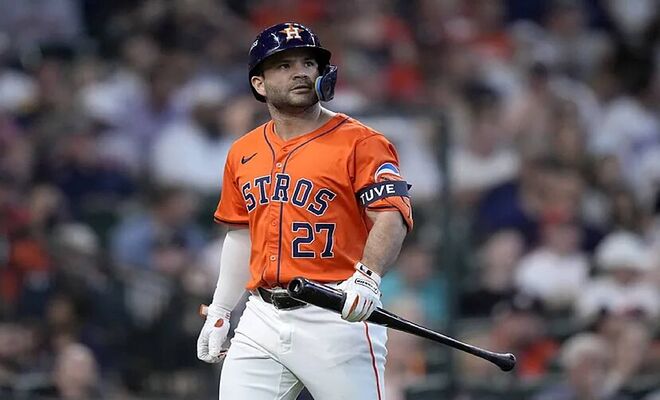-
 October 27, 2025, 2:48 pm
October 27, 2025, 2:48 pmLast Updated on October 27, 2025 2:48 pm by Paul Williamson | Published: October 27, 2025
Record
Pre-Season Projection (FanGraphs) Standings 87-75 82-80 2nd in AL West (3 GB)
From an outsider’s perspective, this felt like a down year for the Astros in terms of how we’ve viewed them comparative to years past when they were steamrolling opponents on their way to winning two World Series. However, based on just their pre-season expectations, the Astros actually put together a strong showing as collective. Unfortunately from a fantasy angle, the team’s success came largely from steady contributions from edge of the roster players, rather than providing us much excitement when it came to breakout players. Though we did finally see a step forward from shortstop Jeremy Pena, one of the biggest hype pieces entering the year – Yainer Diaz – failed to live up to draft expectations for what he could provide managers at the plate.
Catcher
As just mentioned, Yainer Diaz entered the year with the expectations of making a name for himself as a bonafide top-5 fantasy catcher as he was coming off a campaign in which he launched 16 home runs while hitting .299 over 148 games. Diaz did improve in the power department, tallying 20 home runs across 143 games played, but saw his contact-quality metrics drag down his totals, leading to a career-worst .256 average and .701 OPS. Though he had never been much of a walker (career rate: 3.6%) and often finds himself among the worst in the league when it comes to chasing pitches outside the zone (2nd-percentile in 2024; 1st-percentile in 2025), Diaz had managed to leverage strong hard-hit rates to buoy his numbers. However, the 2025 season saw him drop from a 47.5% hard-hit rate (85th-percentile) the year prior to 42.2% – which put him firmly below average, in the 45th-percentile. Consistently chasing pitches out of the zone will usually lead to pitchers taking advantage, often causing weak contact that leads to outs. He’ll still be in the prime age-zone for catcher production next year but he’ll need to show improvement in pitch discipline to truly breakout in the way we previously expected… Victor Caratini may be one of the better backup options for those in deep formats, or two-catcher leagues. Even though Diaz managed to play 143 games, Caratini still received 114 starts of his own, split between backstop, first base, and designated hitter. In those outings, he put forth a strong .259/.324/.404 batting line with 12 home runs and a wRC+ that was four percent better than league average. He even underperformed his xSLG by about 30 points, so his numbers could have looked even better with a bit of luck.
First Base
It’s always risky buying big on aging first basemen and Christian Walker is no exception. In terms of raw counting stats, Walker’s last year in Arizona and his first year in Houston don’t look all too dissimilar, as he went from 26 to 27 home runs, 84 to 88 RBI, and matched his 72 runs scored. His average did drop from .251 to .238, but that’s probably just statistical noise, right? Wrong. Walker’s metrics point to the potential that a cliff is coming for the veteran, as he saw his previously strong plate discipline crater. Many sluggers make their profile work despite racking up whiffs and strikeouts at a high rate – after all, that’s often the necessary tradeoff for increased power – but Walker was often around the middle of the pack in that regard in years past. This year, he instead found himself among the dregs of the league, with a 14th-percentile finish in whiff rate and a 9th-percentile placing in strikeout rate. Most concerning is that his walk rate made an even more alarming drop, going from 10.0% (73rd-percentile) to 6.3% (26th-percentile), meaning he really wasn’t seeing the ball well in any facet of the game. Though bat speed doesn’t always directly correlate to increased power, it can sometimes be a canary in the coal mine for a player who is fading physically. And in this case, we saw Walker dip from an 89th-percentile mark in the category, to an 80th-percentile finish in 2025. There’s still value to be had in a low average slugger at first base, considering the lack of depth at the position currently, but be careful in drafting him in hopes of a full rebound.
Second Base
Jose Altuve continues to age incredibly gracefully. Now in his age-35 season, Altuve finds himself with a new defensive home in left field but continues to put up a solid blend of power and speed, with 26 home runs and 10 steals across 155 games played. Comparing his actual stats to his Statcast metrics suggests he may have been fortunate to put forth his .265/.329/.442 line, as he outperformed his xBA by 20 points and his xSLG by 48 points, but Altuve is one of the rare players that has managed to consistently beat the projections. In fact, Altuve has been able to do so every single year of his career – minus the truncated 2020 season. You can point to trash can banging as much as you want, but clearly Altuve is an outlier that the system is unable to properly account for. In other words, don’t blindly follow the numbers – sometimes what actually happens on the field is more important, and Altuve keeps on proving he’s a valuable contributor. He also managed enough games at the keystone to retain his second base eligibility for next year, so he will remain on the fantasy radar for at least one more season at very minimum… Ramon Urias got most of his starts this year at third base but handled second base as the backup option 26 times, giving him dual eligibility entering next year. The 31-year-old is likely more of a stopgap option though, as he showcased a career-worst wRC+ of 87 while slashing .241/.292/.384 with 11 home runs in 112 games played.
Third Base
Carlos Correa found himself back home in H-Town after a trade with the Twins sent him back to the team after three (injury-marred) seasons in Minnesota. Prior to the trade, Correa had been batting .267/.319/.386 with seven home runs but his return seemed to bring his bat back to life, as he improved to a much stronger line of .290/.355/.430 with six long balls from that point forward. Though he played in 135-or-more games in two of his three seasons in Minnesota, the story around Correa was that he often played through nagging ailments that caused him to struggle at the plate – and eventually convinced the Twins brass to cut bait with their big free agent signing. Though it seemed like a sunk cost at the time, if Correa is able to continue at the rate he did once he donned an Astros jersey once more, that decision could come back to bite them. With Jeremy Pena entrenched at shortstop, Houston instead put Correa at third base, which should help keep him somewhat healthier while lowering his defensive responsibilities – which, together, could help boost his performance at the plate. Third base is a weaker position for fantasy than it has been in the past, so with Correa retaining eligibility at both shortstop and third entering 2026, he could prove to be an underrated asset at draft time.
Of course, he’ll also be competing for time with Isaac Paredes, who carried a 128 wRC+ in 2025 on the strength of a .254/.352/.458 slash line while launching 20 home runs. Without much defensive versatility of his own, it’ll be interesting to see how his deployment is handled, as the only two positions he received starts at last year were third base and designated hitter – a position that is usually filled by Yordan Alvarez, when not dealing with injuries as he did this season.
Shortstop
After putting on an impressive showing during the 2022 season – particularly in the playoffs – that put him on the map as a high-upside middle infielder, Jeremy Pena followed that performance up with two mediocre years, where he carried wRC+ rates that were slightly below league average. He finally lived up to expectations in 2025 though, with career-best marks in average, on-base percentage and slugging. Though buoyed somewhat by a .345 BABIP, Pena saw a strong improvement in his hard-hit rate, raising it by 4.1% to 42.9% overall. Even with that improvement though, he still performed slightly below league average, coming in with a 48th-percentile showing. He also remained decidedly poor when it came to his batting eye, with a 31st-percentile whiff rate, 28th-percentile walk rate, and a 11th-percentile chase rate. With all that in mind, I would expect not-insignificant regression to the mean when it comes to his .304/.363/.477 batting numbers, likely landing in the middle ground between his performances of the last two seasons. Roughly splitting the difference, that still lands him with something like a .280 average, .330 on base percentage, and .440 slugging. I still expect his home run totals to remain in the same range though, so he will remain a top-10 shortstop in my eyes, but perhaps towards the back end of that cohort.
Want to get access to the rest of Jeff’s article? You’ll need to have an MLB FantasyPass membership. Click here to learn more and sign up!
Premium Access RequiredClick here to join us on Discord!
And Follow us on Twitter by clicking here
Come join us at SportsEthos by filling out an application by clicking here
Follow Jeff at @EthosJeff
